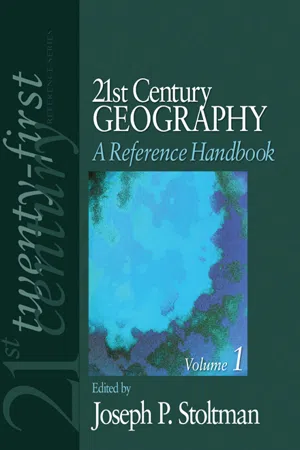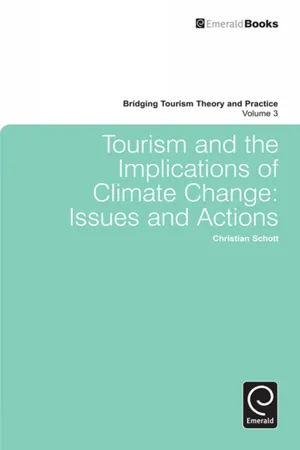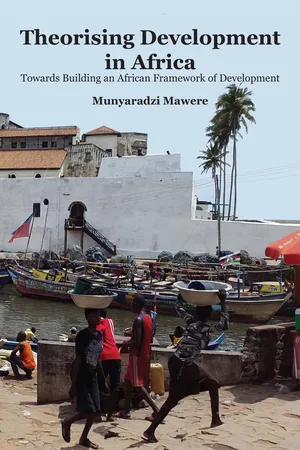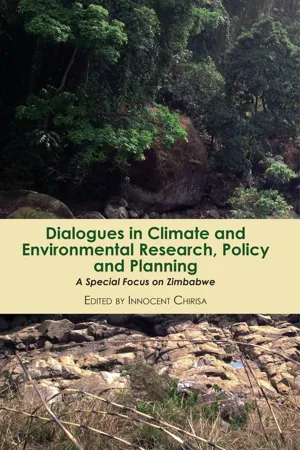Geography
Managing Climate Change
Managing climate change involves implementing strategies to mitigate its impacts and adapt to its effects. This includes reducing greenhouse gas emissions, transitioning to renewable energy sources, implementing sustainable land use practices, and developing resilient infrastructure. Additionally, it involves international cooperation and policy frameworks to address the global nature of climate change.
Written by Perlego with AI-assistance
Related key terms
1 of 5
5 Key excerpts on "Managing Climate Change"
- eBook - ePub
- Peter Howard, Ian Thompson, Emma Waterton, Mick Atha, Peter Howard, Ian Thompson, Emma Waterton, Mick Atha(Authors)
- 2018(Publication Date)
- Taylor & Francis(Publisher)
A second challenge lies in the enormous size and motility of climate change as a topic, which, like landscape, exhibits cross-disciplinary appeal, its study located in everything from physics and biology to sociology and literature. Climate change as a global problem has moved relatively swiftly into high profile political debates over the past 25 years or so, with a concomitant diffusion from the natural sciences into the social sciences (Batterbury 2008). The study of the human dimensions of climate change has been growing in momentum through research which attempts to describe and evaluate perceptions of climate change, understand more about risk and assess the construction of policy (see, for example, Döring and Ratter 2017; Blok 2017; Di Gregorio et al. 2017). Nevertheless, the work of social scientists in respect of climate change is clearly felt to be incomplete, judging by recent calls that important work still needs to be done to understand the sites, spaces and practices of climate change (Leyshon 2014; see also Barnett 2010). This offers the possibility of enriching scientific research and policy development, creating improved knowledge of the complexity of human-environment systems and providing a more nuanced and effective response to global challenges, such as climate change.Finally, not only are the scholarly realms in which landscape and climate change come together very diverse, there is also a significant area of policy to consider as governments and agencies strive to manage current landscapes for future change. For example, the publication of The Natural Choice Natural Environment White Paper (Defra 2011; see also Lawton et al. (2010) Making Space for Nature) in the UK puts landscape-scale working squarely at the heart of a vision of environmental management that uses an ecosystem services approach. A range of institutional strategic documents attempt to both identify how climate change will affect each institution’s operations, priorities and mission, and communicate this in a way that attempts to build a consensus around a shared vision of the future, grounded in the management of landscapes. These include the Wildlife Trust’s A Living Landscape (2008); Natural England’s The Natural Environment: Adapting to Climate Change (2008); the National Trust’s Shifting Shores - eBook - PDF
- Joseph P. Stoltman(Author)
- 2011(Publication Date)
- SAGE Publications, Inc(Publisher)
It has been suggested that we need some- thing akin to the National Centers for Disease Control to address the health of the planet (Kieffer, 2009), perhaps in an effort to emphasize the increasing number of planetary symptoms associated with ongoing global change and a system that is now functioning differently from just a few decades ago. Geographers and other scientists know that the plane- tary system is adjusting and changing in new and unique ways. Are there good ideas from within the realm of geo- graphic thought that can be of assistance as we navigate an uncertain future? This chapter discusses the theory, obser- vations, and projections about multiple changes to Earth's conditions and processes, and the consequences of these changes. The major focus on climate change in the past 2 decades has provided the impetus for geographers and other scientists to examine and theorize regarding other types of change. The climate change studies served some- what as a catalyst for the scholarly community to measure and conceptualize the ongoing experiment that humans are conducting with their planetary home. Geography has a long history of focus on human- environment relations, or nature-society linkages (Turner, 2002). The emphasis of this chapter is on seven ideas: complexity, the importance of the local, synthesis, sustain- ability science, vulnerability science, land change science, and geographic information science (GIScience), as repre- sented by geographers. These ideas help characterize ongoing changes and provide perspectives that can be used to help people better manage their actions and effects on the planet as societies move further into what E. O. Wilson (2002) described as the developing bottleneck of over- population and the wasteful practice of overconsumption. Wilson was addressing a narrowing gap between available planetary resources and rapidly increasing human demands on those resources. - eBook - PDF
Tourism and the Implications of Climate Change
Issues and Actions
- Christian Schott(Author)
- 2010(Publication Date)
- Emerald Group Publishing Limited(Publisher)
INTRODUCTION Climate change is probably one, if not the most serious problem that mankind faces. The United Nations (UN) Secretary General, Ban Ki-Moon, in his opening remarks to the UN Climate Change Summit Plenary (September 2009) stated that ‘‘climate change is the pre-eminent geopolitical and economic issue of the 21 st century’’. It is also an extraordinarily difficult issue due to the complex network of anthropogenic drivers, impacts of and responses to climate change, and their linkages. To make the problem more complicated, political actions addressing climate change have to take other closely related challenges in the socioeconomic domain into consideration, such as sustainable development and equity issues. The term climate change in this chapter refers to any change in climate over time, whether due to natural variability or as a result of human activity. This usage differs from that used in the United Nations Framework Convention on Climate Change (UNFCCC), where climate change refers to a change of climate that is attributed directly or indirectly to human activity that alters the composition of the global atmosphere and that is in addition to natural climate variability observed over comparable time periods. Once the problem and the consequences of climate change are recognized different, parallel lines of action can be followed in response to it. Firstly, one should act directly on the causes of climate change. As the warming of the climate system is very likely caused by the steady increase of atmospheric concentrations of greenhouse gases (GHGs) since the beginning of the industrial era, mitigation strategies must be pursued to aim at reducing GHG emissions and expanding and enhancing carbon sinks. - eBook - PDF
Theorising Development in Africa
Towards Building an African Framework of Development
- Munyaradzi Mawere(Author)
- 2017(Publication Date)
- Langaa RPCIG(Publisher)
151 Chapter 9 Climate Change and Environmental Management Strategies in Africa “Climate change is both natural and anthropogenic, but the geographical location and poverty situation of Africa will always make her more vulnerable than any other continent on earth” (Mawere 2016). Introduction Since the Second World War, climate change has caused a quandary of problems thereby becoming a menace to the nations of the world. It has, for instance, caused serious environmental change and affected the socio-economic development of many societies especially those in the developing world. While even the industrialised countries of the global south have been affected by climate, the impact of climate change has been worse in Africa than anywhere else in the world due to various factors which include geographical location, poverty, poor technology, and lack of adaptive capacity, among others. Also, environmental change on the continent has exacerbated the development gridlock of the African continent such that its drivers and impacts are worth studying. That said, this chapter assesses the impact of climate change on socio-economic development in Africa, but realising their plenteousness which in fact would need a whole book to capture comprehensively, only a selected number of impacts will be assessed. In this whole attempt, the chapter begins by shading more light on the conceptualisation of the concepts of ‘climate change’ and ‘environmental change’ before looking at the drivers of the latter. Last but not least, the chapter looks at climate change adaptation and mitigation in Africa in view of the threats posed and opportunities opened up by climate change. 152 Climate Change Climate change (also known as global warming) has caused a lot of changes on the environment and in human life over the years. - eBook - PDF
Dialogues in Climate and Environmental R
A Special Focus on Zimbabwe
- Innocent Chirisa(Author)
- 2020(Publication Date)
- Langaa RPCIG(Publisher)
121 Chapter 7 Climate Change Governance and Physical Planning in Zimbabwe Liaison Mukarwi & Wendy Tsoriyo Introduction and Background Across the globe, climate change intensifies the hazards that affect the social systems and weakens resilience of states in tackling uncertainty and disasters (O’Brien et al. 2006). It also contributes to increased climate extremes (droughts, heat waves, cyclones etc.) and exacerbates adverse impacts (extreme hunger and poverty) (Birkmann and Mechler, 2015). Zimbabwe, like many countries, is experiencing drastic effects of climate change hence the need to prioritise the climate change reduction, mitigation and adaptation alike. The incoming of Sustainable Development Goals (SDGs) particularly, SDG Number 13 which speaks to the need to take urgent action to combat climate change and its impacts, among other global efforts also affirms the global world’s commitment to combat and adapt to climate change. To this end, Zimbabwe signed the Paris Climate Change Agreement and pledged its commitment to mitigate and adapt the phenomenon in line with SDGs. Zimbabwe has also set a target of reducing greenhouse gas emissions by 33 percent as a way of operationalizing and walking the talk on climate change (Gukurume, 2013; Rankomise, 2015). Other efforts include the drafting of the National Climate Change Response Strategy (NCCRS) in 2013 which stated the national action plan for adaptation and mitigation, analysis of strategy enablers (e.g. capacity building, climate change education, communication and awareness), climate change governance and implementation framework (IEED, 2013). Also, the Environmental Management Act established environment related agencies and provisions aiming to provide for the sustainable management of natural resources and protection of the environment and the prevention of pollution and environmental degradation (Gukurume, 2013).
Index pages curate the most relevant extracts from our library of academic textbooks. They’ve been created using an in-house natural language model (NLM), each adding context and meaning to key research topics.




